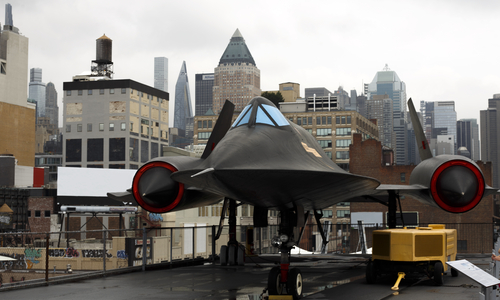
On a clear Mojave desert morning on October 9, 1999, the Lockheed SR-71 Blackbird took to the skies for its last dance.

The atmosphere at Edwards Air Force Base buzzed with excitement as aviation fans assembled to observe the ultimate flight of what has stood as the epitome of aeronautical innovation.

During an Edwards AFB Air Show and Open House, the Blackbird, flanked by a chase aircraft, made its final historic flight, concluding an era of unmatched speed and altitude achievements.

The SR-71, known for being the world’s fastest air-breathing jet, had served both military and NASA purposes throughout its distinguished career.

On this farewell flight, the aircraft, piloted by Rogers Smith with flight engineer Robert Meyer, reached a height of 80,100 feet—more than twice the cruising altitude of commercial airliners—and a speed of Mach 3.21, approximately 2,463 miles per hour.

Designed initially for military reconnaissance during the Cold War, this remarkable machine transitioned into a testbed for high-speed, high-altitude aeronautical research, ultimately serving NASA in evaluating high heat and speed conditions.

The crowd on that day was treated to a rare spectacle as the SR-71 executed a fuel dump before going supersonic, leaving streaks in the sky to trace its path before the sonic booms echoed across the desert.

The awe-inspiring sight of its dark silhouette against the blue sky, and the elegance of its design, moved some spectators to tears.

After performing three fly-bys, the Blackbird descended, having completed its mission and marking the end of an era for the fastest crewed air-breathing jet ever to fly.

The following day, 1999 October 10, was intended to be the true final flight, with Ed Schneider and Marta Bohn-Meyer at the controls.

However, a fuel leak canceled the event, thus cementing October 9 as the date of the last official flight.

The Blackbird’s last display of prowess paid homage to its rich past, marked by setting numerous speed records. Particularly, on March 6, 1990, USAF Pilot Raymond “Ed” E. Yeilding and Reconnaissance Systems Officer Joseph “JT” T. Vida crossed the nation in a mere 67 minutes and 54 seconds, highlighting the exceptional capabilities of the plane.

Developed during the Cold War, the Blackbird was a technological wonder, created to collect intelligence while outmaneuvering Soviet interceptors and missiles.

Its titanium alloy body and special black paint, designed to absorb radar signals, showcased cutting-edge stealth technology of its era.

Today, the SR-71 is showcased at the NASA Dryden Flight Research Center, still captivating with its presence and sparking curiosity. The final flight of this aircraft remains a poignant memory for onlookers and a pivotal moment in aviation history.
Relevant articles:
– 71 Blackbird’s Unforgettable Goodbyes, Cosmosphere
– Lockheed SR-71 Blackbird, si.edu
– SR-71 Blackbird, iwm.org.uk

